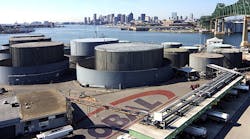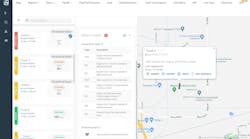CONSISTENCY is the goal of the Globally Harmonized System of Classification and Labeling of Chemicals (GHS), a method of standardizing and harmonizing the classification and labeling of chemicals, according to James Hall, manager of the WCM Group Inc.
He said it is now being proposed and would take effect no earlier than 2015. He described the pending GHS system during the National Tank Truck Carriers' Tank Cleaning & Environmental Council annual seminar June 4-5 in New Orleans, Louisiana.
“The focus is to have everything consistent worldwide,” Hall said. “With regard to MSDS (material safety data sheets), you no longer would get one from Dow that looks like this, and another one from another facility that looks like this. It'll be consistent all the way through.”
GHS is a worldwide initiative to promote standard criteria for classifying chemicals according to their health, physical, and environmental hazards. It uses pictograms, hazard statements, and signal words such as DANGER and WARNING to communicate hazard information on product labels and safety data sheets in a logical and comprehensive way.
“It'll be like kindergarten: Don't touch this,” Hall said.
Hall said its impact will be to open the gate for international commerce and ease the import-export of chemicals.
He said the GHS itself is not a regulation or a standard. The GHS Document (referred to as “The Purple Book“) establishes agreed hazard classification and communication provisions with explanatory information on how to apply the system.
“Many countries, such as ours, already have regulatory systems in place,” he said. “These systems may be similar in content and approach, but their differences are significant enough to require multiple classifications, labels, and safety data sheets for the same product. This leads to inconsistent protection for those potentially exposed to the chemicals, as well as creating extensive regulatory burdens on companies producing chemicals.
“For example, in the United States there are requirements for classification and labeling of chemicals from a variety of agencies. The same product can have different classification/labels from the Consumer Product Safety Commission, the Department of Transportation, the Environmental Protection Agency, and the Occupational Safety and Health Administration.
“I deal with this a lot. I deal with hazardous waste. I deal with the terminal manager, and he's wondering why I'm labeling it non-hazardous while on the manifest it says hazardous. Under GHS, the objective is to put it on a consistent track. So if it's hazardous here, it's hazardous there.”
GHS elements
The elements in the GHS supply a mechanism to meet the basic requirement of any hazard communication system, which is to decide if the chemical produced and/or supplied is hazardous and to prepare a label and/or safety data sheet as appropriate. This helps to ensure the safe use of chemicals as they move through the product life cycle from “cradle to grave,” he said.
For example, a product may be considered flammable or toxic by one agency or country, but not by another.
The most important force that drove the creation of the GHS, he said, was the international mandate adopted in the 1992 United Nations Conference on Environment and Development (UNCED), often called the “Earth Summit.”
The harmonization of classification and labeling of chemicals was one of six program areas that were endorsed by the United Nations to strengthen international efforts concerning the environmentally sound management of chemicals. A harmonized approach to classification and labeling would provide the foundation for all countries to develop comprehensive national programs to ensure the safe use of chemicals.
GHS benefits to companies:
-
A safer work environment and improved relations with employees.
-
An increase in efficiency and reduced costs from compliance with hazard communication regulations.
-
Application of expert systems resulting in maximizing expert resources and minimizing labor and costs.
-
Facilitation of electronic transmission systems with international scope.
-
Expanded use of training programs on health and safety.
-
Reduced costs due to fewer accidents and illnesses.
GHS benefits to workers:
-
Improved safety for workers and others through consistent and simplified communications on chemical hazards and practices to follow for safe handling and use.
-
Greater awareness of hazards, resulting in safer use of chemicals in the workplace.
He said it is expected that application of the GHS will be similar to application of current transport requirements. GHS physical, acute, and environmental hazard criteria are expected to be adopted in the transport sector. Containers of dangerous goods will have pictograms that address acute toxicity, physical hazards, and environmental hazards. GHS hazard communication elements such as signal words, hazard statements, and SDS are not expected to be adopted in the transport sector.
In the workplace, it is expected that application of the GHS will include physical and health hazard criteria, as appropriate: labels that have the harmonized core information under the GHS (signal words, hazard statements and symbols, etc.); safety data sheets; and employee training to help ensure effective communication. He said all workplace systems may not have the jurisdiction to adopt environmental hazards.
Standardized labels
The standardized label elements included in the GHS are:
-
Symbols (hazard pictograms): Convey health, physical and environmental hazard information, assigned to a GHS hazard class and category.
-
Signal words: DANGER or WARNING are used to emphasize hazards and indicate the relative level of severity of the hazard, assigned to a GHS hazard class and category.
-
Hazard statements: Standard phrases assigned to a hazard class and category that describe the nature of the hazard.
The symbols, signal words, and hazard statements have all been standardized and assigned to specific hazard categories and classes, as appropriate.
The GHS symbols have been incorporated into pictograms for use on the GHS label. For transport, pictograms will have the background, symbol, and colors currently used in the UN Recommendations on the Transport of Dangerous Goods, Model Regulations. For other sectors, pictograms will have a black symbol on a white background with a red diamond frame. A black frame may be used for shipments within one country.
He said the MSDS sheets provide comprehensive information for use in workplace chemical management. Employers and workers use the MSDS as sources of information about hazards and to obtain advice on safety precautions. The GHS MSDS headings, sequence, and content are similar to the ANSI MSDS/SDS requirements.
The GHS states the importance of training all target audiences to recognize and interpret label and/or SDS information, and to take appropriate action in response to chemical hazards, he said. Training requirements should be appropriate for the nature of the work or exposure. Key target audiences include workers, emergency responders, those responsible for developing labels and SDSs, and persons involved in transport.
“I talked with some friends in the EPA, and this can go all the way across the board,” he said. “It doesn't go with just how you label chemicals on site. When this goes through, there will be a three-year grace period to comply in a timely manner. But if you have products sitting around that are four or five years old, they will have to be re-labeled. Because if OSHA comes out and catches packaging with outdated labels, they'll ding you. People at EPA said they will probably do hazardous waste labels using the same GHS system. Hazardous waste labels should remain the same, but will have these pictograms, so you will be required to have another diamond on it. I can see an avalanche of new regulations coming.”
Recent actions
Recent environmental enforcement actions:
-
A Connecticut dairy manufacturer agreed to pay a $299,999 penalty for repeated wastewater discharge violations. According to DEP, on numerous occasions the manufacturer bypassed its wastewater collection and treatment equipment and manually overrode all alarm equipment resulting in untreated wastewater discharge into the sanitary sewer system.
-
A private trucking fleet was fined $75,000 by NJDEP after a diesel spill of 30 gallons. The truck swerved to avoid hitting a car and scraped a saddle tank against a guardrail, puncturing the tank. The driver used a spill kit to stop the flow from the tank and the company filed a full accident report with the state police. The fine resulted from a failure to comply with state's environmental reporting. The state police did not mention the requirement and the company thought it had done everything necessary.








